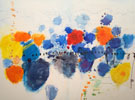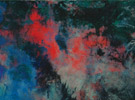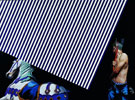Stated differently, Sun Yao’s picture, like his other works, operates like an opaque mirror that reflects humanity unsettled and possibly even in a state of disequilibrium. This is formally and conceptually underscored in a plethora of ways including the painting’s undulating prominent light that comes from the upper right hand corner and sharply cuts a diagonal down the center to the bottom left hand side. It concomitantly creates a swirling mass of illumination set against the contours and edges of flora. In turn, this photonic cascade seems to anchor and simultaneously diffuse matter multi-directionally. Effervescently kaleidoscopic, shadow and light are equally as contingent to each other in this masterful composition as silence is to sound, as negative absence is to a sculpture’s presence. Interplay, dialectic, and point/counterpoint between darkness and its other, as well as the manifold gradations in between these two poles are germane to the overall monochrome of Sun Yao’s palette. This work, as well as the general corpus of the Deep Forest series, takes the monochrome from its historical context and conflates it with an older artistic from, consequently arriving at a distinct aesthetic that is unquestionably the style of Sun Yao.
One artist that comes to mind who similarly works with the monochrome but within the context of thematic figuration is Mark Tansey. Tansey’s psychologically driven narratives undermine the monochrome’s history that was often thought to be solely the register of Minimalism and earlier forms of pure, geometric abstraction. Sun Yao, however, not only tropes these with verve and deftness but his work also reaches farther back to the genre of the grisaille. The Gothic artists Jean Pucelle and Giotto, as well as those from the Renaissance including Pieter Bruegel the Elder, Mantegna, and the Mannerist painter and engraver Hendrik Goltzius, were just a few among many that worked in grisaille for practical and aesthetic reasons. Another aspect of the grisaille that is the consensus is that in lesser artistic hands, the inferior artist is quickly revealed. This has to do with the fact that the artist cannot obscure his talent or lack thereof, behind polychromatic painting.
When looking at Sun Yao’s painting with their monochromatic palette and attendant grisaille reference, it becomes apparent the breadth and depth of this artist’s talent. For in reducing his color range to the singular, it not only underscores his mastery of the medium, but one understands how germane light and dark is for his artistic practice. Light is a key factor in No. 15, as it is in Sun Yao’s other pictures, and adds formal texture and compositional buoyancy while heightening emotional content. This is how Sun Yao breaks from his Romantic antecedents and moves his practice into more contemporary artistic registers whose aesthetic vocabulary is akin, for example, to the desolate landscapes of Anselm Kiefer. But Sun Yao’s paintings are, however, polyvalent and lend themselves to broader narratives that poetically explore the condition of self as an aggregate to a geographical gestalt. His arborous imagery is, of course, offset by the infusion of anthropomorphic forms. Individuals seem to vaporize before our eyes as the artist interjects more than humanoid phantoms; for their emotive qualities are cathartically conveyed through the coupling of figuration and landscape. Look, for instance at another exemplary work from the Deep Forest series such as No. 14 (2010)
No. 15 is arborous yet evocatively atmospheric. Most works by Sun Yao from the Deep Forest series have this ethereal quality to them; the dialectic between the tangible and the seemingly vaporous gives the paintings a visually poetic temperament of levity and gravity. But whereas No. 15 has these attributes of lightness and density, of an admixture of both center and periphery through a painterly dispersion, No. 14 takes on an earthier material form. Continuing with Sun Yao’s mainstay of forest and phantasmagoria, this work may be characterized as being more terrestrial if not subterranean. It transmits materiality much more than other paintings of these series via what appears to be a vast underground interiority. The faces and bodies in No. 14 have different resonance than No. 15 by virtue of their association within and above the geography on which Sun Yao portrays a wide range of human emotions. Varied and complex, most of the artist’s iconography of bodies and faces of both genders, work ostensibly in equal cohesion; here and there, however, it seems that he can also paint this configuration the other way around. In No. 7, for example, a monumental face seems to dominate the composition to the degree that bodies as well as the forest and flora are subservient to it.
The hallucinatory visage is archetypal: because of its overpowering presence, one cannot help think of Jungian psychology and the archetype. And like the famed psychologist’s theory of the collective unconscious from where these archetypes emerge, the forms that make up No. 7 and that gel together to make up eyes, nose mouth and so forth confront that viewer in a more direct manner. Other works generally have this larger face that meshes with arborous signifiers, but it may be that No. 7 is the most unsettling. While the artist has never mentioned as to the source or what this or any other forms mean to him, it would not be out to the realm of possibility that the monumental face on where is placed other figures may be a self-portrait. Not self-portrait in the traditional sense, because the rendering is not close to the artist’s likeness, but it could be that the overpowering visage that dominates and is recurring motif, is an alter ego of the artist. In this sense, Sun Yao has come full circle. For though other artists had grappled with the sublime as manifesting in nature externally, Sun Yao’s sublime is one of interiority.
Sun Yao’s art is a metaphorical journey into the deepest recesses of our being where we may dread not to go, confront, or come to terms with. The reason for this is as much our complacency as it is a negation of what Socrates once stated in the affirmative, to know thyself. Self-knowledge may be the most demanding undertaking for it takes a brutal honesty. Sun Yao’s paintings are testament to his artistic authenticity; he creates work not only for aesthetic reasons but is deeply committed to a practice that is engaged with life as well as philosophical questions including the nature of being. In the pilgrimage that he calls art, he is telling us through this beautiful complex body of work that it may be that the self is elusive only because we are it. The farther we move away from ourselves, the farther the self becomes. Sun Yao’s paintings are visual poetic mappings if his own peregrination through a forest of imagination; in short, it is a topography of the self.
Curator’s bio:
Raúl Zamudio is New York-based independent curator and critic, and has curated more than 70 exhibitions in the Americas, Europe, and Asia; including co-curator, “City Without Walls,” 2010 Liverpool Biennial; co-curator, Constellations: 2009 Beijing 798 Biennial, co-curator, Turn and Widen: 2008 Seoul International Media Art Biennial, and artistic director, Garden of Delight: 2008 Yeosu International Contemporary Art Festival. He has authored, co-authored, or contributed to more than 40 books and catalogs.










